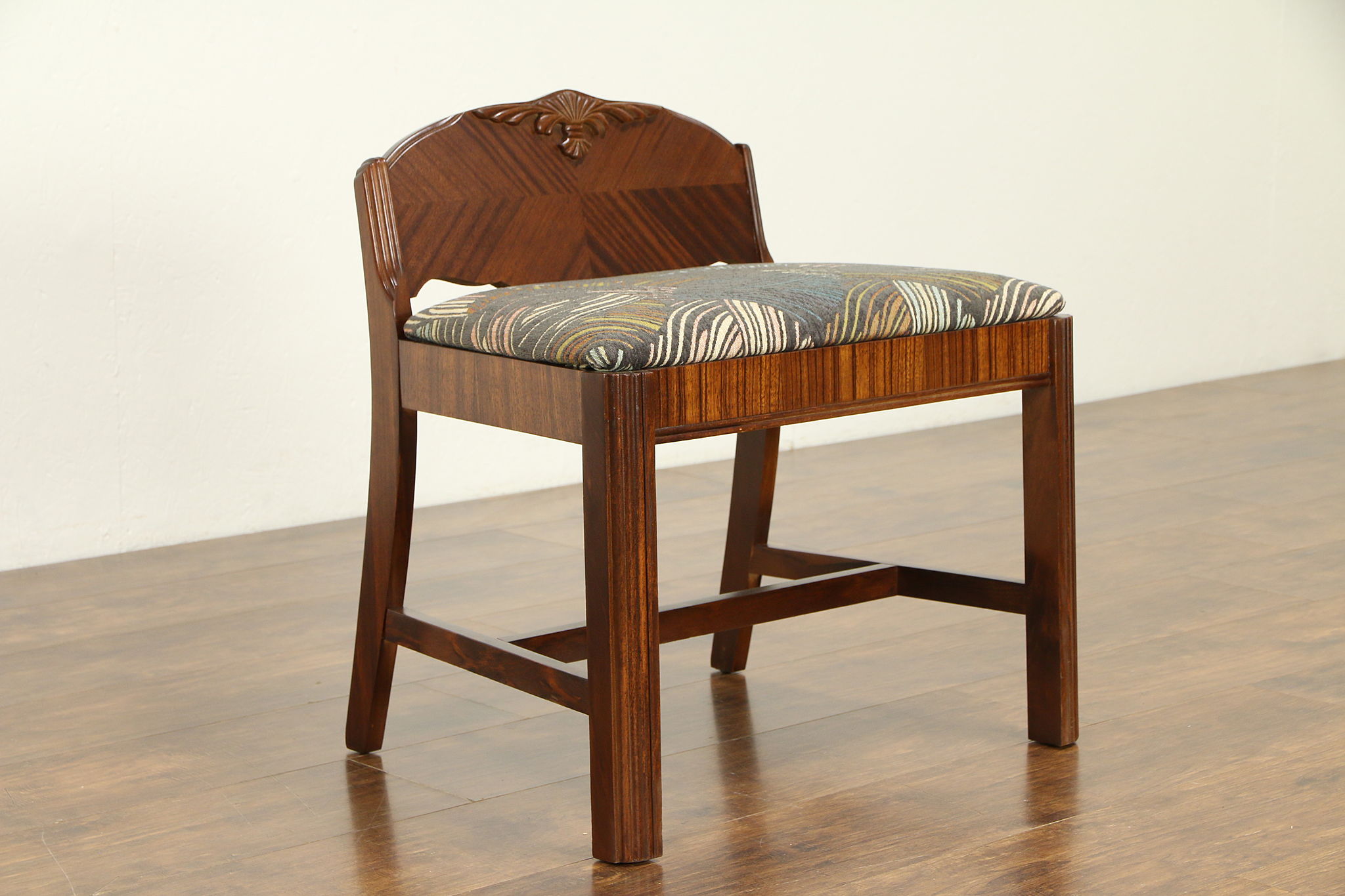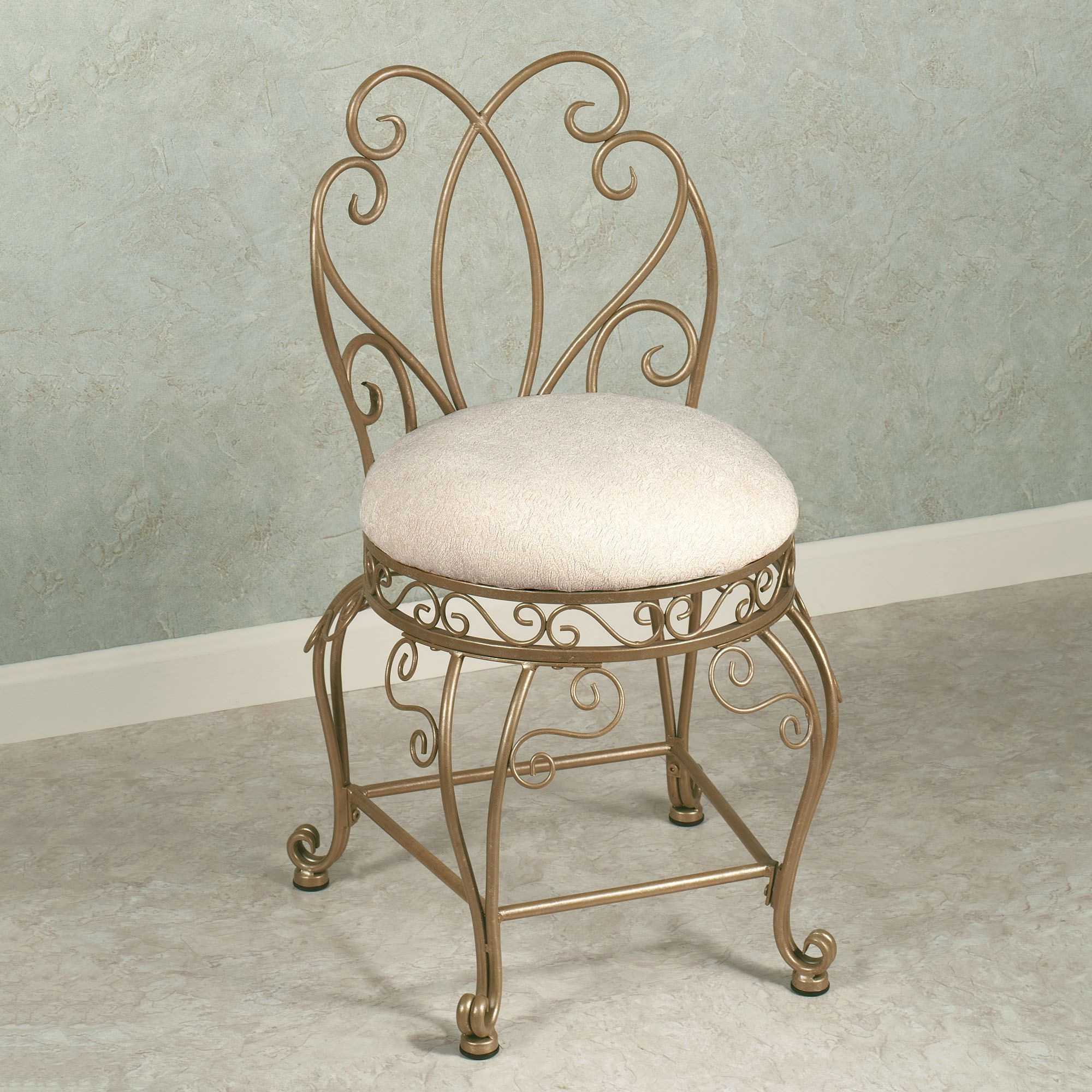History and Evolution of Vanity Chairs with Backs: Vintage Vanity Chair With Back

Vanity chairs with backs, often associated with elegance and practicality, have a rich history that reflects changing styles and trends throughout the ages. Their evolution can be traced from their humble beginnings to the sophisticated designs found in modern homes.
Early Origins and Evolution, Vintage vanity chair with back
The earliest vanity chairs with backs were simple, functional pieces of furniture. They were often made of wood and had a basic design, typically with a solid back and a seat. These early chairs were primarily used for practical purposes, such as dressing and grooming.
- Ancient Egypt: Evidence suggests that early forms of vanity chairs existed in ancient Egypt. These chairs were often made of wood and decorated with intricate carvings or paintings.
- Medieval Period: During the Medieval period, vanity chairs became more elaborate. They were often made of oak or other hardwoods and featured carved backs, arms, and legs.
- Renaissance: The Renaissance era saw a shift towards more ornate designs. Vanity chairs were often decorated with intricate carvings, tapestries, and other decorative elements. They were also becoming more comfortable, with padded seats and backs.
Notable Vintage Vanity Chairs with Backs
Over the centuries, a variety of notable vanity chairs with backs have emerged, each reflecting the aesthetic preferences and design trends of their respective eras.
- The Chippendale Vanity Chair: Chippendale vanity chairs, popular in the 18th century, are characterized by their elegant, intricate designs. They often feature cabriole legs, carved backs, and padded seats.
- The Victorian Vanity Chair: Victorian vanity chairs, popular in the 19th century, are known for their ornate designs and opulent materials. They often feature elaborate carvings, plush upholstery, and decorative details like fringe and tassels.
- The Art Deco Vanity Chair: Art Deco vanity chairs, popular in the 1920s and 1930s, are characterized by their geometric designs and bold colors. They often feature sleek lines, chrome accents, and geometric patterns.
Materials and Construction Techniques
The materials and construction techniques used in vintage vanity chairs with backs varied significantly throughout history.
- Wood: Wood was the primary material used for vanity chairs throughout history. Oak, mahogany, cherry, and walnut were common choices for their durability and aesthetic appeal.
- Upholstery: Upholstery materials evolved over time. Early vanity chairs were often simply padded with straw or horsehair. Later chairs featured more luxurious materials such as velvet, brocade, and leather.
- Metal: Metal, particularly iron and brass, was increasingly used in the construction of vanity chairs in the 19th and 20th centuries. These metals were often used for decorative elements, such as legs, arms, and back supports.
Decorative Elements
Vintage vanity chairs with backs were often adorned with a variety of decorative elements that enhanced their beauty and elegance.
- Carving: Carving was a popular decorative technique used on vanity chairs, especially during the Renaissance, Baroque, and Victorian eras. Carvings could be simple or elaborate, featuring floral motifs, geometric patterns, or scenes from mythology.
- Inlay: Inlay was another popular decorative technique, involving the use of different materials to create intricate patterns. Wood, ivory, mother-of-pearl, and other materials were used to create stunning designs on vanity chair surfaces.
- Paint: Painting was often used to decorate vanity chairs, adding color and vibrancy to their designs. Paints were used to create simple patterns or elaborate scenes.
Styles and Designs of Vintage Vanity Chairs with Backs

Vintage vanity chairs with backs are a testament to the evolving tastes and design principles of different eras. From the opulence of Victorian styles to the sleek minimalism of Mid-Century Modern, these chairs reflect the artistic and cultural trends of their time. Examining the distinct characteristics of these styles allows us to appreciate the craftsmanship and aesthetic values that have shaped their enduring appeal.
Popular Styles of Vintage Vanity Chairs with Backs
Vintage vanity chairs with backs encompass a wide array of styles, each with its own unique design principles and characteristics. Here are some of the most popular styles:
| Style | Description | Notable Features | Examples |
|---|---|---|---|
| Hollywood Regency | Characterized by a glamorous and sophisticated aesthetic, often featuring bold geometric patterns, metallic accents, and luxurious fabrics. | High-backed chairs with dramatic curves, tufted upholstery, and sleek lines. Often use materials like velvet, silk, and chrome. | A vanity chair with a high back, curved arms, and a mirrored base. It may feature tufted upholstery in a bold color like emerald green or sapphire blue, and accents like gold-plated hardware. |
| Art Deco | Defined by its geometric shapes, streamlined forms, and luxurious materials. It emphasizes a sense of modernity and sophistication. | Often feature bold geometric patterns, sleek lines, and luxurious materials like chrome, glass, and ebony wood. Chairs may have geometric backrests, cantilevered arms, and a polished finish. | A vanity chair with a geometric backrest, a cantilevered arm, and a chrome base. It may feature upholstery in a geometric pattern or a bold color like black or white. |
| Mid-Century Modern | Characterized by its clean lines, simple forms, and functional design. It embraces a sense of minimalism and natural materials. | Often feature simple forms, clean lines, and a focus on functionality. They often use materials like wood, leather, and metal. | A vanity chair with a low back, tapered legs, and a simple, streamlined design. It may feature upholstery in a neutral color like beige or brown, and accents like brass hardware. |
| Victorian | Known for its ornate designs, elaborate details, and luxurious materials. It emphasizes a sense of grandeur and opulence. | Often feature intricate carvings, detailed upholstery, and a wide range of materials like mahogany, rosewood, and velvet. Chairs may have high backs, curved arms, and a sense of grandeur. | A vanity chair with a high back, carved details, and tufted upholstery. It may feature a luxurious fabric like velvet or silk, and accents like brass hardware. |
Restoring and Upcycling Vintage Vanity Chairs with Backs

Restoring and upcycling vintage vanity chairs with backs can be a rewarding experience, breathing new life into these elegant pieces and adding a touch of vintage charm to your home decor. By understanding the process and techniques involved, you can transform these chairs into unique and functional furniture pieces that reflect your personal style.
Restoring Vintage Vanity Chairs with Backs
Restoring vintage vanity chairs involves a series of steps that aim to bring the chair back to its original glory. This process involves cleaning, refinishing, upholstery, and repairs, each contributing to the overall restoration.
Cleaning and Preparation
The first step in restoring a vintage vanity chair is to thoroughly clean it. This removes dust, dirt, and grime that can obscure the chair’s true beauty.
- Use a soft cloth or vacuum cleaner with a brush attachment to remove loose dust and debris from the chair’s surface.
- For stubborn stains, you can use a mild soap and water solution, applying it with a damp cloth and gently rubbing the affected areas.
- Allow the chair to dry completely before proceeding to the next step.
Refinishing
Refinishing the chair’s wood surface can restore its original color and shine, enhancing its aesthetic appeal.
- If the chair’s finish is damaged or chipped, you may need to strip it using a chemical stripper. This process removes the existing finish, allowing you to apply a new one.
- Once the old finish is removed, sand the wood surface with progressively finer grit sandpaper to create a smooth finish.
- Apply a wood stain to achieve the desired color, allowing it to dry completely before applying a sealant or varnish to protect the finish.
Upholstery
Upholstery is a crucial aspect of restoring a vintage vanity chair, as it determines the chair’s comfort and overall appearance.
- Assess the condition of the existing upholstery, noting any tears, rips, or loose seams.
- If the upholstery is beyond repair, you may need to replace it with new fabric. This involves removing the old upholstery, measuring the chair’s dimensions, and cutting new fabric to fit.
- Secure the new fabric to the chair’s frame using staples or upholstery tacks, ensuring a smooth and even finish.
Repairs
During the restoration process, you may encounter minor repairs, such as loose joints or broken legs.
- For loose joints, tighten the screws or use wood glue to reinforce the connection.
- If a leg is broken, you can repair it using wood glue and clamps or by replacing the damaged section with a new piece of wood.
Upcycling Vintage Vanity Chairs with Backs
Upcycling vintage vanity chairs involves transforming them into unique and functional pieces of furniture that reflect your creativity and personal style.
Painting
Painting the chair with vibrant colors or unique patterns can give it a modern and stylish look.
“A simple coat of bold paint can instantly transform a vintage vanity chair into a statement piece.”
Adding Storage
Adding storage compartments or shelves to the chair can enhance its functionality and provide a place to store your belongings.
“Attaching a small shelf to the back of the chair can create a convenient space for displaying books or decorative items.”
Adding Cushions
Adding plush cushions to the seat and back of the chair can enhance its comfort and add a touch of elegance.
“You can use contrasting colors or patterns for the cushions to create a unique and eye-catching design.”
Creating a Desk
A vintage vanity chair can be transformed into a functional desk by adding a tabletop to the back of the chair.
“This creates a compact and stylish desk that is perfect for small spaces.”
Creating a Headboard
A vintage vanity chair can be repurposed as a headboard for a bed, adding a touch of vintage charm to your bedroom.
“You can simply attach the chair to the wall behind the bed or use it as a decorative element at the foot of the bed.”
The vintage vanity chair with back, often adorned with delicate carvings and plush velvet upholstery, evokes a sense of timeless elegance. Its smaller scale, perfect for a dressing table, finds a modern counterpart in the mini wing back chair , a charming statement piece for a cozy corner.
Both designs, with their embrace of comfort and intricate details, offer a touch of vintage charm to any space.
The vintage vanity chair with its plush back and elegant curves may seem like a relic of a bygone era, but its design principles still hold relevance today. After all, proper posture is key to comfort, and the wrong chair can lead to discomfort and even pain.
If you find yourself experiencing back pain from sitting for long periods, it’s worth considering the ergonomic aspects of your seating, perhaps even researching the risks associated with office chair causing back pain. While a vintage vanity chair might not be ideal for long work sessions, its timeless design can inspire you to prioritize comfort and support in your seating choices, no matter what the occasion.